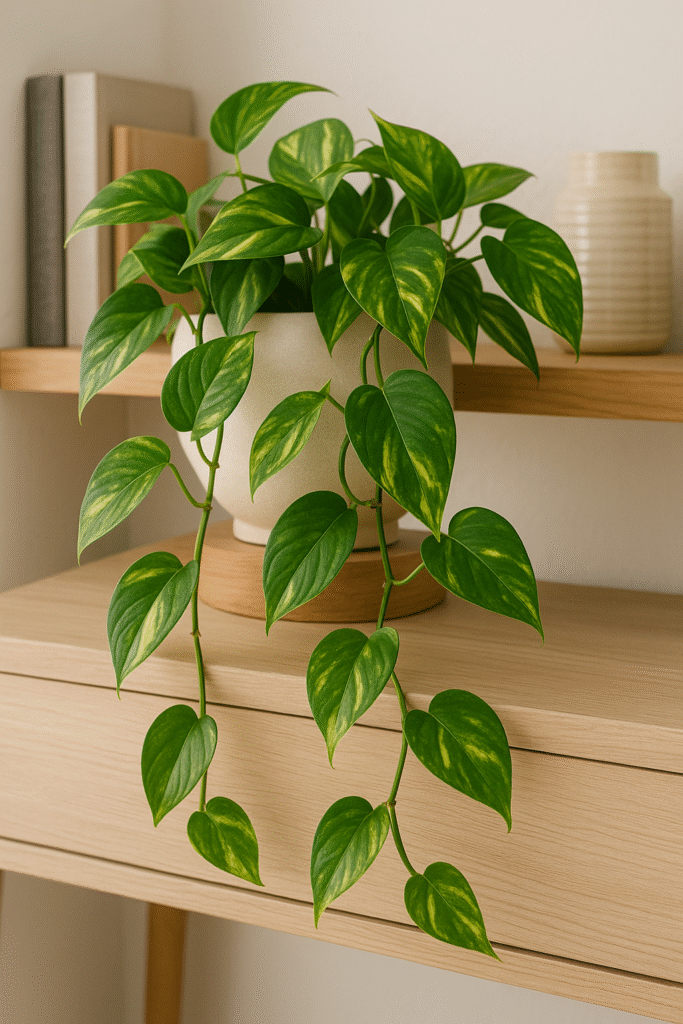The pothos plant (Epipremnum pinnatum), also known as devil’s ivy or golden pothos, is one of the most popular ornamental plants in Brazilian homes. With its heart-shaped leaves in vibrant green and golden patterns, it enhances any space — whether it’s an apartment, office, or balcony. Beyond its beauty, it’s also hardy, easy to care for, and known for purifying indoor air.
In this article, you’ll learn all about pothos: its origin, characteristics, benefits, and practical care tips to keep it thriving in your home.
🌱 Origin and Characteristics of the Pothos Plant
Though common in Brazilian households, pothos is originally native to French Polynesia. It has adapted perfectly to tropical and humid climates and is now cultivated in many parts of the world. Pothos is a perennial vine, meaning it can grow quite long under the right conditions — whether in hanging pots, climbing structures, or even in the ground.
Its leaves are the main highlight. They range from deep green to light green with yellow or white variegation, depending on the variety. It’s ideal for indoor decoration as it thrives in indirect light and doesn’t demand intensive care.
🌬️ Benefits of Having Pothos Indoors
Keeping a pothos plant at home brings more than just aesthetic value. According to NASA studies on air-purifying plants, the Epipremnum genus can help remove toxins such as formaldehyde, xylene, and benzene from the air. That makes pothos a great natural air purifier for enclosed spaces.
Additional benefits include:
- Helps maintain natural humidity in the air.
- Reduces visual stress with its vibrant green color.
- Requires low maintenance, ideal for beginners.
🪴 How to Care for Pothos: Complete Guide
Here’s a practical guide with everything you need to know to keep your pothos healthy and beautiful.
1. Light Requirements
Pothos prefers bright, indirect light or partial shade. It tolerates lower light conditions, but its growth will slow down and the variegation on the leaves may fade. Avoid placing it in direct sunlight, as this can scorch the leaves.
Tip: Place it near a bright window or on a shelf where it can receive diffused natural light.
2. Watering
The rule of thumb is: only water when the soil feels dry to the touch. Overwatering is one of the most common causes of root rot in pothos.
- In summer: water 2 times a week.
- In winter: once a week or less, depending on humidity levels.
Important: Always use pots with drainage holes!
3. Pruning and Training
Pothos can be pruned to control its size or to encourage bushier growth. Use clean scissors to cut stems just above a leaf node. You can also train it to climb or let it trail from a hanging pot or shelf.
Bonus tip: Use the cuttings to propagate new plants. Simply place the cut stems in water until they develop roots, then transplant them to soil.
4. Fertilizing
Fertilize your pothos every 30 to 60 days with a liquid fertilizer for foliage plants. This promotes growth and enhances the shine and color of the leaves.
5. Pests and Diseases
While pothos is generally pest-resistant, it can be affected by mealybugs, spider mites, or fungus in overly dry or overly wet conditions. A natural remedy is neem oil or diluted neutral soap to remove the pests.
⚠️ Is Pothos Toxic?
Yes. Pothos contains calcium oxalate crystals that can cause irritation if ingested by children or pets. Make sure to keep the plant out of reach of cats, dogs, and little ones.
🌿 Is It Worth Having a Pothos at Home?
Absolutely! Pothos is one of the best beginner-friendly houseplants, and a great choice for anyone looking to add greenery to their indoor environment with minimal effort. With proper care, it can live for many years and turn any room into a natural, calming space.

Discover Rare and Beautiful Succulents
Looking for unique, healthy, and eye-catching succulents? At Leaf & Clay, you’ll find exotic varieties perfect for any indoor garden or tropical plant collection.
Explore their curated selection and get inspired to grow something extraordinary today
From traditional medicine to ecological value, explore why this native plant is considered a natural treasure of Brazilian flora.

